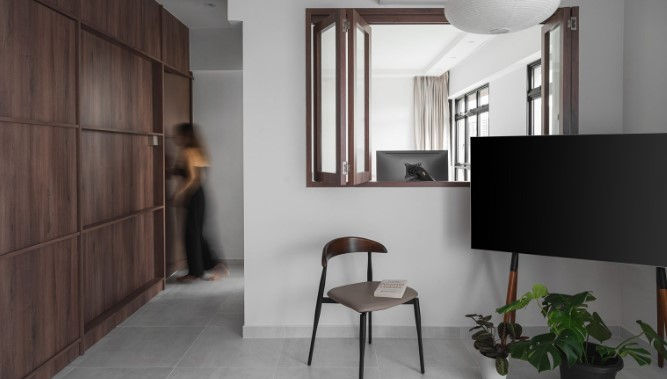Embrace Serenity: The Art of Minimalist Interior Design
- payjaman05
- Aug 6
- 4 min read
In today’s fast-paced world, where our lives are often filled with constant noise and clutter, the philosophy of minimalist interior design offers a powerful and calming antidote. This approach is more than just a passing trend; it's a deliberate choice to create a home that serves as a sanctuary of peace, clarity, and intentional living. Minimalist design is not about living in an empty, stark space, but rather about a thoughtful curation of your environment to support a calmer, more mindful way of life.
By stripping away the superfluous, you reveal the true beauty and purpose of your home. It's about focusing on quality over quantity, transforming your living space from a collection of possessions into a tranquil retreat.
What is Minimalist Interior Design?
At its core, minimalist design is guided by the principle of "less is more." It’s a purposeful effort to eliminate visual noise and promote a sense of order. A truly minimalist space is defined by a few key characteristics:
Clean Lines and Simple Forms: Furniture and decor feature straightforward, elegant silhouettes without ornate details. Think of a sleek, armless sofa, a simple geometric coffee table, or a frameless mirror. These elements create a sense of calm and precision.
A Muted Color Palette: The foundation of a minimalist room is a neutral color palette. Whites, grays, beiges, and blacks create a sense of harmony and make a space feel more expansive. Any color is used sparingly, often as a deliberate accent to draw the eye, such as a single green plant or a piece of vibrant art.
Uncluttered Surfaces: Every item in a minimalist home has a purpose and a place. Countertops, tables, and floors are kept largely free of clutter, which helps to reduce subconscious stress and allows for effortless movement and tidiness.
Emphasis on Natural Light: Minimalist design maximizes natural light to create a bright and airy atmosphere. Large windows, sheer curtains, and reflective surfaces like mirrors help to bounce light around the room, making it feel larger and more open.
High-Quality, Durable Materials: Rather than filling a space with many inexpensive items, the minimalist approach favors investing in a few high-quality, well-crafted pieces that will last for years. This focus on durability and timelessness is a cornerstone of the philosophy.
The Transformative Benefits of a Minimalist Home
Adopting a minimalist approach to your home is a holistic choice that brings a host of practical and psychological benefits:
Reduces Stress and Anxiety: A cluttered environment can be a major source of subconscious stress. A clean, organized, and intentional space helps to calm the mind and create a peaceful sanctuary where you can truly relax and recharge.
Easier to Clean and Maintain: With fewer possessions and simpler furniture, cleaning becomes a quicker, more manageable task. This frees up your valuable time and energy for hobbies, family, and self-care.
Encourages Intentional Living: Minimalism forces you to be mindful of what you bring into your home. Each purchase becomes a deliberate choice, leading to a deeper appreciation for your belongings and reducing impulsive spending.
Promotes Better Focus: Without the distraction of visual clutter, a minimalist space can be a more productive environment for working, studying, or simply enjoying a quiet moment of reflection.
Highlights Architectural Beauty: When unnecessary decor is removed, the unique features of your home—such as a beautiful floor, an interesting window, or high ceilings—are allowed to shine as a natural part of the design.
Your Guide to Achieving a Minimalist Look
Ready to begin your journey to a more serene home? Follow these actionable steps to embrace minimalist design:
Declutter with Purpose: The most crucial first step is to let go of what you don't need, use, or love. Start with one room or even just one surface. Be ruthless and honest with yourself about what truly adds value to your life.
Choose a Neutral Foundation: Paint your walls in a calming, neutral shade like white, off-white, or a light gray. This creates a versatile and timeless canvas for your space.
Invest in Multi-Functional Furniture: Look for pieces that serve more than one purpose, such as an ottoman with hidden storage, a coffee table with built-in shelves, or a sofa bed. This maximizes functionality without adding visual clutter.
Embrace Negative Space: Don't feel the need to fill every corner. Negative space, or the area around and between objects, is a fundamental part of minimalist design. It allows the eye to rest and creates a sense of balance and openness.
Add Warmth with Texture: To prevent your home from feeling cold or sterile, introduce warmth through different textures. Think about a soft wool rug, a linen throw blanket, a woven basket, or the rich grain of a wooden table.
Decorate with Intention: Limit your decorative items to a few carefully chosen pieces that you genuinely love. A single piece of art, a beautiful plant, or a unique lamp can be all you need to make a powerful statement.
By embracing the principles of minimalist interior design, you’re not just redecorating; you’re transforming your home into a sanctuary that reflects a mindful and intentional way of life. It’s an invitation to appreciate the quiet beauty in the simple things and find a profound sense of calm in the place you call home.




Comments